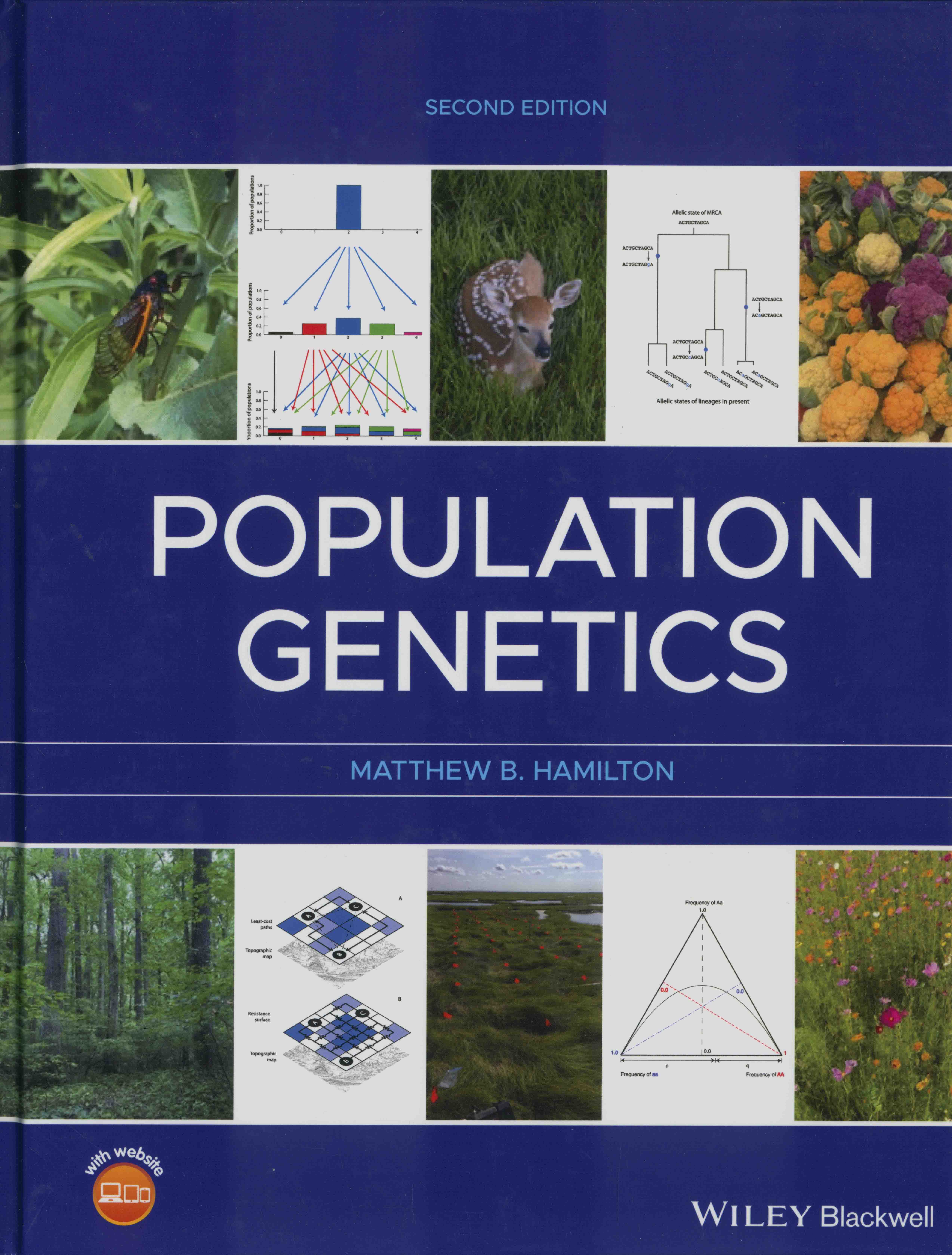 |
Population genetics / Matthew B. Hamilton. -- 2nd edition. -- Hoboken, NJ : Wiley-Blackwell, 2021. – (59.34/H218/2nd ed.) |
Contents
Preface and acknowledgements, xiv
About the companion websites, xvi
1 Thinking like a population geneticist, 1
1.1 Expectations, 1
1.2 Theory and assumptions, 4
1.3 Simulation, 5
Chapter 1 review, 7
Further reading, 7
2 Genotype frequencies, 8
2.1 Mendel's model of particulate genetics, 8
2.2 Hardy-Weinberg expected genotype frequencies, 12
2.3 Why does Hardy-Weinberg work?, 15
2.4 Applications of Hardy-Weinberg, 18
2.5 The fixation index and heterozygosity, 26
2.6 Mating among relatives, 31
2.7 Hardy-Weinberg for two loci, 42
Chapter 2 review, 52
Further reading, 52
End-of-chapter exercises, 53
Problem box answers, 54
3 Genetic drift and effective population size, 5 7
3.1 The effects of sampling lead to genetic drift, 57
3.2 Models of genetic drift, 62
3.3 Effective population size, 76
3.4 Parallelism between Drift and mating among relatives, 81
3.5 Estimating effective population size, 85
3.6 Gene genealogies and the coalescent model, 92
3.7 Effective population size in the coalescent model, 103
3.8 Genetic drift and the coalescent with other models of life history, 108
Chapter 3 review, 110
Further reading, 111
End of chapter exercises, 111
Problem box answers, 113
4 Population structure and gene flow, 115
4.1 Genetic populations, 115
4.2 Gene flow and its impact on allele frequencies in multiple subpopulations, 122
4.3 Direct measures of gene flow, 127
4.4 Fixation indices to summarize the pattern of population subdivision, 135
4.5 Population subdivision and the Wahlund effect, 142
4.6 Evolutionary models that predict patterns of population structure, 148
4.7 Population assignment and clustering, 160
4.8 The impact of population structure on genealogical branching, 169
Chapter 4 review, 176
Further reading, 177
End of chapter exercises, 178
Problem box answers, 180
5 Mutation, 183
5.1 The source of all genetic variation, 183
5.2 The fate of a new mutation, 191
5.3 Mutation models, 201
5.4 The influence of mutation on allele frequency and autozygosity, 207
5.5 The coalescent model with mutation, 213
Chapter 5 review, 217
Further reading, 218
End-of-chapter exercises, 219
6 Fundamentals of natural selection, 220
6.1 Natural selection, 220
6.2 General results for natural selection on a diallelic locus, 230
6.3 How natural selection works to increase average fitness, 238
6.4 Ramifications of the one locus, two allele model of natural selection, 243
Chapter 6 review, 246
Further reading, 247
End-of-chapter exercises, 247
Problem box answers, 248
7 Further models of natural selection, 250
7.1 Viability selection with three alleles or two loci, 250
7.2 Alternative models of natural selection, 259
7.3 Combining natural selection with other processes, 266
7.4 Natural selection in genealogical branching models, 277
7.5 Shifting balance theory, 284
Chapter 7 review, 292
Further reading, 293
End-of-chapter exercises, 293
Problem box answers, 294
8 Molecular evolution, 296
8.1 Neutral theory, 296
8.2 Natural selection, 305
8.3 Measures of divergence and polymorphism, 313
8.4 DNA sequence divergence and the molecular clock, 324
8.5 Testing the molecular clock hypothesis and explanations for rate variation in molecular evolution, 329
8.6 Testing the neutral theory null model of DNA sequence polymorphism, 339
8.7 Recombination in the genealogical branching model, 350
Chapter 8 review, 354
Further reading, 355
End-of-chapter exercises, 356
Problem box answers, 357
9 Quantitative trait variation and evolution, 359
9.1 Quantitative traits, 359
9.2 Evolutionary change in quantitative traits, 374
9.3 Quantitative trait loci (QTL), 393
Chapter 9 review, 408
Further reading, 409
End-of-chapter exercises, 409
Problem box answers, 410
10 The Mendelian basis of quantitative trait variation, 413
10.1 The connection between particulate inheritance and quantitative trait variation, 413
10.2 Mean genotypic value in a population, 415
10.3 Average effect of an allele, 416
10.4 Breeding value and dominance deviation, 420
10.5 Components of total genotypic variance, 428
10.6 Genotypic resemblance between relatives, 431
Chapter 10 review, 433
Further reading, 434
End-of-chapter exercises, 434
Problem box answers, 434
Appendix, 436
Problem A.1 Estimating the variance, 438
Interact box A.1 The central limit theorem, 439
A.1 Covariance and Correlation, 440
Further reading, 442
Problem box answers, 442
Bibliography, 443
Index, 468